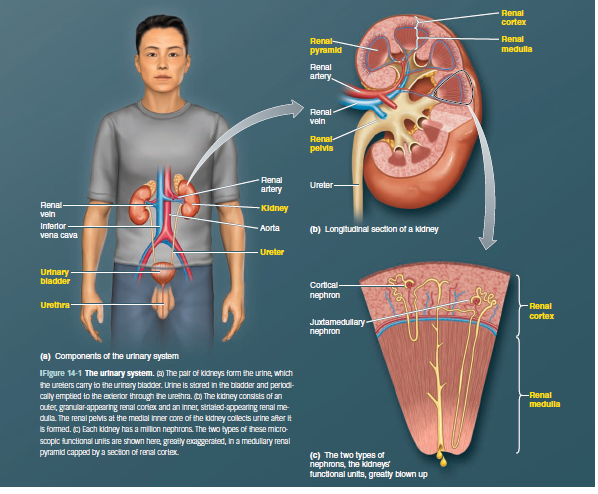
The Urinary System: Functional Anatomy and Urine Formation by the Kidneys
Most people are familiar with one important function of the kidneys—to rid the body of waste materials that are either ingested or produced by metabolism. A second function that is especially critical is to control the volume and electrolyte composition of the body fluids. For water and virtually all electrolytes in the body, the balance between intake (due to ingestion or metabolic production) and output (due to excretion or metabolic consumption) is maintained largely by the kidneys. This regulatory function of the kidneys maintains the stable internal environment necessary for the cells to perform their various activities.
The kidneys perform their most important functions by filtering the plasma and removing substances from the filtrate at variable rates, depending on the needs of the body. Ultimately, the kidneys “clear” unwanted substances from the filtrate (and therefore from the blood) by excreting them in the urine while returning substances that are needed back to the blood. The kidneys serve many important homeostatic functions, including the following: • Excretion of metabolic waste products and foreign chemicals • Regulation of water and electrolyte balances • Regulation of body fluid osmolality and electrolyte concentrations • Regulation of arterial pressure • Regulation of acid-base balance • Regulation of erythrocyte production • Secretion, metabolism, and excretion of hormones • Gluconeogenesis
At the end of the lesson, students will be able to learn about;
PHYSIOLOGICAL ANATOMY OF THE KIDNEYS
PHYSIOLOGICAL ANATOMY OF THE BLADDER AND MICTURITION & ITS ABNORMALITIES
TRANSPORT OF URINE FROM THE KIDNEY THROUGH THE URETERS AND INTO THE BLADDER
URINE FORMATION RESULTS FROM GLOMERULAR FILTRATION, TUBULAR REABSORPTION, AND TUBULAR SECRETION


